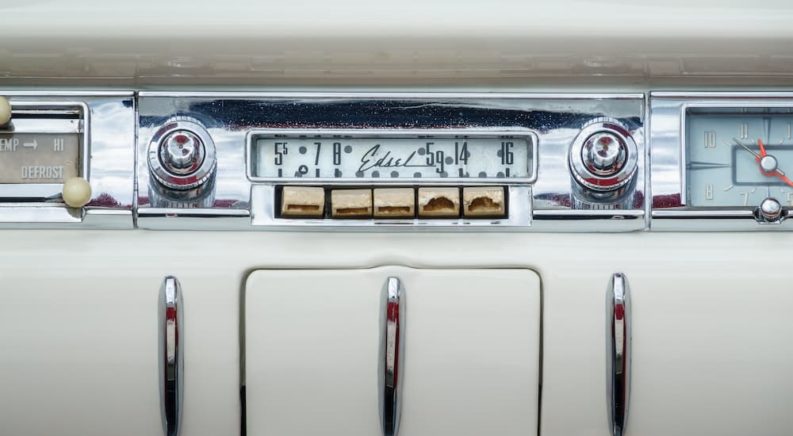When you visit your local Ford dealer, you’re certainly not going to find the subject of this article on display. You won’t find the Ford Edsel for sale anywhere else, unless you search far and wide, attending a wide variety of car auctions across all fifty states. Even then, you MIGHT find one out there somewhere.
The Ford Edsel has long been the butt of many jokes, the subject of ridicule, and considered by some to be a masterclass in terrible business decisions. Fate has dealt a cruel blow to this vehicle. While the 1957 Chevy Bel Air is often romanticized as a symbol of a carefree time and vintage Americana, the Edsel is deemed a failure that inexplicably has never been redeemed—nor praised for its unique design. We’re here to change that, and to extoll the virtues of a car that was too good for its time.
What’s in a Name?
To our modern tastes and sensibilities, the name “Edsel” seems almost comical. Just as finding a Ford Edsel is difficult, you’d be hard pressed to find an individual with that name today. It’s sort of like “Horatio” or “Thaddeus” in its antiquated naming. However, the car’s namesake is a tragic tale of a father outliving his son—and a company paying homage to his memory. The best intentions can have terrible consequences, and this is certainly one case in a long history of many.
Edsel Bryant Ford was the son of Ford founder and industrialist Henry Ford. While Henry was a man of practicality, being the mastermind behind the Model T and the implementation of mass production, Edsel was the type of person who looked ahead and saw potential. He expressed excitement about what the automobile could someday harness. As president of the Ford Motor Company, Edsel was responsible for the development of Mercury and Lincoln, and even had a hand in the industrialization of combat vehicles following America’s entry into the second world war. While his contributions to the war effort certainly had a significant influence on Allied victory, it would be something he wouldn’t live to witness.
Edsel Ford would shuffle off the mortal coil in 1943 after developing cancer. Following his passing, Henry Ford briefly assumed the mantle of control of the company until 1945. This is what makes the tale of the Ford Edsel such a tragic one. For such a visionary and philanthropist to have his legacy overshadowed—by an automobile he had no hand in making—is one of the great cruel jokes history has played on its unwilling participants.
1958 – The Ford Edsel Comes of Age
The year is 1958; poodle skirts, jukeboxes, and an overwhelming fear of communism are some of the motifs dominating the American landscape. It’s in this backdrop of carefree innocence that the Ford Edsel debuts. While no one could have foreseen the failure that was to come, an error in timing most likely doomed the Edsel from the very start. The period after World War II ushered in a large economic boom, which saw a wide variety of consumer goods released and the American dream fully realized by a great populace who wanted nothing more than peacetime to thrive. However, in 1958 came an economic recession, so a brand-new midsize automobile was just an impractical purchase for many. (Unfortunately, this is also the year that Ford decided to go public.)
Financial difficulties aside, the Edsel had a design that boasted innovation and challenged the common preconceptions of the time. The most recognizable attribute of the Edsel was its front grille. While it turned many consumers away, recognition and praise are due for its unique oval centerpiece that goes against the grain, daring to be different. Its advertising slogan of “makes other cars seem ordinary” is truthful—it describes its ambition and, ultimately, one of the key factors in the car’s eventual downfall. While the Edsel had a genuine appeal, it lacked the practicality that many Americans were beginning to gravitate toward.
The 1958 Edsel featured a V8 that had an impressive horsepower rating of 345. Its total of 18 unique models were available in a convertible, hardtop, and 2-door coupe, so there were certainly options for anyone who wanted to own one. Still, the variety had no effect on discerning consumers who were less than thrilled by Ford seemingly failing to grasp their basic needs.
1959 didn’t fare much better for the Edsel, either. Despite more variations and trims built, its lackluster debut seemed to seal its fate as a failure. This wasn’t remedied by reports of incompetent workmanship at Ford, either. Production of the Ford Edsel would cease before the 1960 model year. Following losses of well over $250 million, its reputation as one of the most spectacular business failures in history was permanently sealed.
A Symbol of Failure or Misplaced Innovation?
The Edsel’s place in history is synonymous with failure. Truth be told, this is a legacy that feels quite undeserving. Had it been released a few years before or after the notable recession that appeared to doom its release from the start, public reception might have been quite different. Its failure might also be attributed to the fact that designs that are sometimes too bold and outside-of-the-box garner an almost instantaneous seal of disapproval. The Edsel was a different type of car, one that dared to stand aside from convention and not embrace it wholly.
And, for all the negativity tossed in its direction, the Edsel was a car that—for better or for worse—attempted to honor its namesake. Edsel Ford was someone who pushed for innovation and didn’t believe that the automobile should be bland. For what it’s worth, it’s easy to see many of the Edsel’s concepts alive and well, reinvented for the modern age.
The Teletouch system that the Edsel made use of—push-button transmission controls on the steering wheel rather than a physical shifter—could easily be seen as the forerunner to the steering wheel paddle shifters we see on modern automobiles in this day and age. The Edsel also featured remote trunk opening and even equipped the speedometer with a limit warning if a preset speed was exceeded. While not nearly as advanced as the driving assistance features that we find on suites such as Ford CoPilot 360, they show a remarkable level of ingenuity and forward thinking—at a time when most automotive tech could be seen as primitive and limiting.
So, how should the Edsel be remembered? Sure, it’s easy to look at the sales figures from several decades ago and dismiss it as a failure. It’s even simpler to look at its place in popular culture and regard it as one of the industry’s first examples of a dumpster fire. Despite everything, it should be remembered that, despite the misgivings, the Edsel and its team of designers possessed significant ambition; they aimed to take things in a direction that the American public might not have been ready for.
Thankfully, this classic Ford does still have its enthusiasts. It’s unique and distinctive, what with its hard-to-find hood ornaments and mid-century flair. What Edsel Ford would have thought of the vehicle is a simple matter of conjecture, yet it was anything but bland and formulaic.




